How to Get Rid of Weeds in Grass
BY LASHONDA TUCKER | AUGUST 7TH, 2023 | BLOGDifferent people have different expectations and goals when it comes to lawn care products to get rid of weeds. Some prioritize getting the task done over any risks chemicals in products may cause. Others place safety over the convenience conventional lawn care products may provide. That is why we present how to get rid of weeds in grass using traditional, synthetic herbicides and safer methods like homemade recipes and manual tips.
With so many ways to get rid of weeds, you do not have to let them confiscate your property.
This article will also cover weed prevention. Keep reading to discover all the options you have for weed control on your lawn.
Identifying Types of Weeds
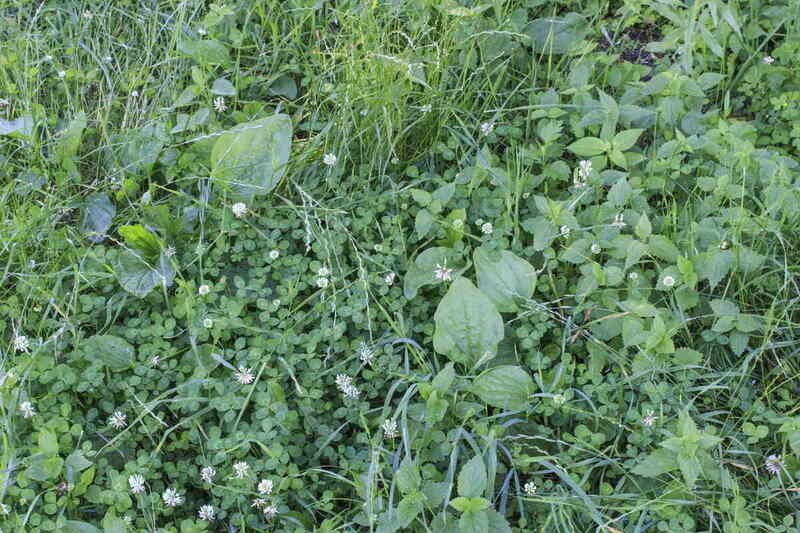
Photo Credit: PxFuel
Weeds are unwanted plants growing in lawns, gardens, and fields. They compete with wanted vegetation for nutrients. Like any other plant, they can be categorized by their life cycles and type. Weeds can be annuals, biennials, or perennials. These unwanted plants fall into three types: broadleaf, grassy, and grass-like.
Before you can get rid of weeds, you have to identify what type they are so you can choose an effective control method. Not all herbicides or manual removal methods work for all weeds.
Life Cycle
Learn a weed’s life cycle to figure out the best time to apply pre-emergent and post-emergent herbicides to control that weed.
Annual weeds live for less than a year and spread by seed. Summer annuals sprout in the spring. They grow in the summer and fall and die in the winter. Crabgrass and goosegrass are some examples. Winter annuals sprout in late summer and early fall. They die when it gets hotter out, in late spring or early summer. Some examples of winter annual weeds are chickweed and henbit.
Biennial weeds have a two-year life cycle and germinate by seed. They are not as common in lawns as annual and perennial weeds. Common burdock and wild carrot are two examples.
Perennial weeds are also spread by seed and by stolons, bulbs, and rhizomes. These weeds are harder to control than annual weeds because they keep coming back, year after year, unless you remove their entire system of growth, including roots, stolons, and rhizomes. Plantain, thistle, and dandelions are some examples.
Type of Weeds
Some chemical treatments are only effective for certain types of weeds or specific weeds within a category. So, you must be able to identify the weeds growing in your grass before you can choose a suitable herbicide.
Broadleaf weeds have broad and flat leaves that are not grass-like. Examples are perennials like thistle, plantain, chickweed, dandelions, and henbit.
Grassy weeds have blades that look like grass. Crabgrass, quackgrass, annual bluegrass, and foxtail are some common grassy weeds.
Grass-like weeds resemble grass but do not look as much like it as grassy weeds. The blades are triangular or tubular and shiny. Some examples are nutsedge, wild garlic, and wild onion.
Once you have identified the type of weed in your yard, you can select the best organic herbicide, homemade weed killer recipe, synthetic herbicide, or manual removal method to control that specific weed.
Get Rid of Weeds with Organic Herbicides
Organic herbicides have ingredients that are safer than the toxic chemicals found in traditional synthetic herbicides. However, you typically will not find these organic herbicides in most kitchens, like you would the options listed in the homemade weed killer section.
Organic weed control products with the following active ingredients can be purchased from stores like Home Depot, Lowe’s, and other home and garden suppliers.
Corn Gluten Meal
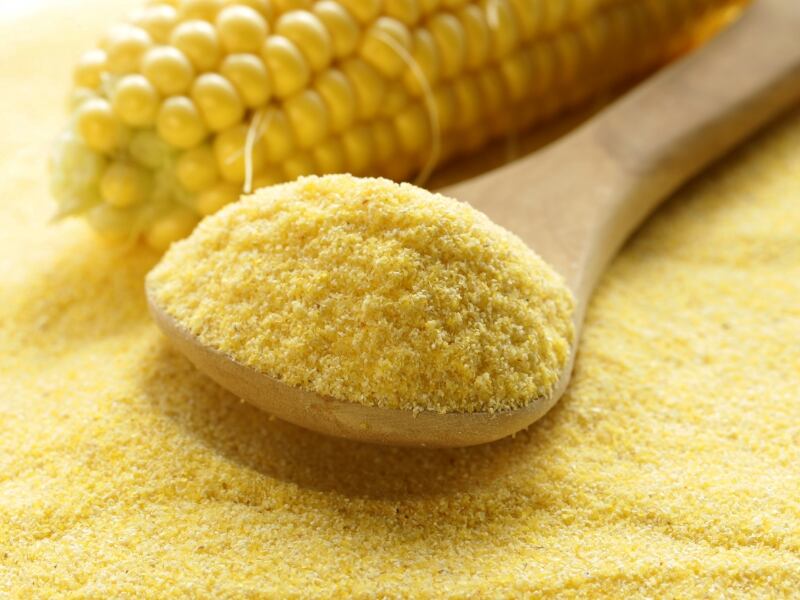
Photo Credit: Olga Kriger / Canva Pro / License
Corn gluten meal acts as a weed and feed product. It kills weed seeds like a pre-emergent herbicide and contains nitrogen to feed the grass.
How to Use It: Corn gluten meal is only effective at preventing weeds and fertilizing grass when the soil is wet, so give the lawn a light spray of water after using this product unless rain is forecasted later in the day to do it for you.
Apply it before weed seeds germinate – in early spring for summer annuals and early fall for winter annuals – because corn gluten meal does nothing to kill weeds that have already sprouted. The nitrogen it contains can actually promote the growth of existing weeds.
Monthly reapplication may be required for lasting control. Corn gluten meal can kill the seeds of weeds like dandelions, crabgrass, henbit, and more.
Herbicidal Vinegar
Vinegar is most effective at killing weeds when the vinegar is 20% acetic acid. The vinegar in your kitchen is only around 5% acetic acid, so you will need a special product called herbicidal vinegar to kill weeds. Herbicidal vinegar is a popular active ingredient in organic post-emergent herbicides. It can kill larger weeds and perennials, but multiple treatments are required.
The acetic acid removes moisture from the plant’s foliage, breaking it down and killing the leaves. A natural surfactant, like yucca extract, is usually included in herbicides to help the vinegar solution stick to the weeds’ leaves.
How to Use It: Herbicidal vinegar is a non-selective herbicide, meaning it kills all plants it comes into contact with, including grass. Never apply vinegar all over your lawn unless you’re trying to kill the existing grass so you can start a new lawn from scratch. Instead, spot-treat unwanted plants by placing the solution in a spray bottle and spraying weeds directly. Many commercial herbicides with vinegar come in a ready-to-spray bottle.
Warning: Herbicidal vinegar can burn the skin and cause severe eye injuries, such as blindness. Wear protective glasses and long sleeves when applying this product.
Eliminate Weeds with Homemade Weed Killers
You can also use ingredients already in your kitchen to make a homemade weed killer for your lawn. These DIY concoctions are safer for pets and humans than the chemicals in synthetic herbicides and much more affordable than organic herbicides you can buy at the store, but they may be less effective than either and may take multiple applications to produce results.
Vinegar Solutions
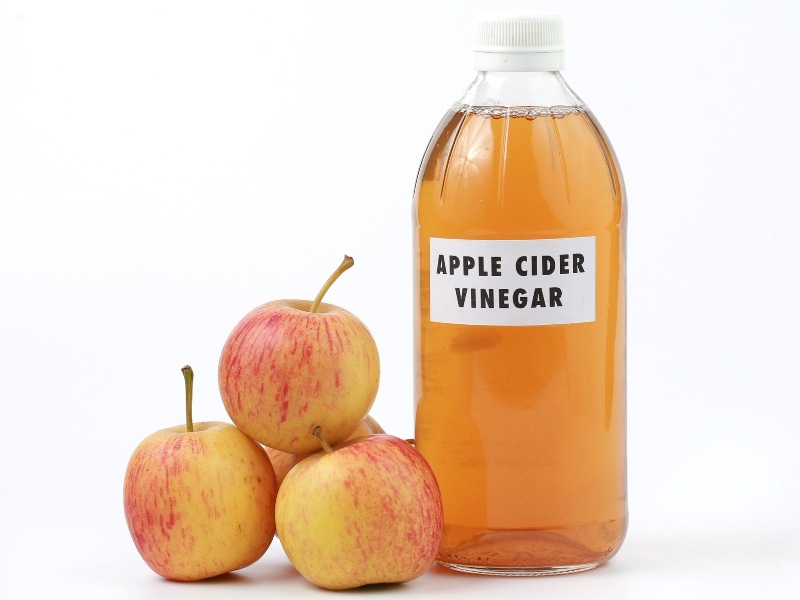
Photo Credit: tylim / Canva Pro / License
Vinegar solutions are a commonly used DIY weed control method. The following are mixtures you can make using regular kitchen vinegar.
White Vinegar Solution:
— 1 gallon of white vinegar
— 1 tablespoon of dish soap
— 1 cup of salt
Apple Cider Vinegar Solution:
— ½ gallon of apple cider vinegar
— ¼ cup of salt
— 1 teaspoon of dish soap
How to Apply: Mix the ingredients thoroughly and place the solution in a handheld spray bottle. Spray directly to weeds on a sunny day. The sun helps the acetic acid in the vinegar work.
This non-selective DIY weed control will kill most broadleaf weeds and other plants, too, so be careful not to spray it directly on your grass. Solutions with 5% acetic acid may not kill dandelions and other plants with taproots. Use herbicidal vinegar for these types of stubborn weeds.
Table Salt
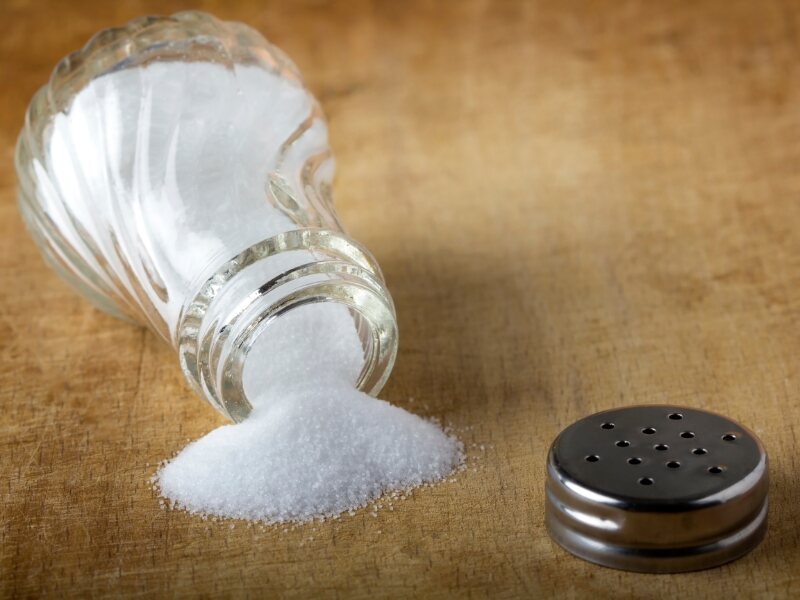
Photo Credit: Sebalos / Canva Pro / License
Salt can change the pH level of the soil, make it sterile, and hurt plants, including weeds. The downside is that salt will also hurt grass and other landscape plants, so apply it only on the soil around weeds.
How to Apply: You can start with a 3-to-1 water-to-salt ratio and increase the amount of salt daily until it kills the weeds. Learn more in our in-depth article about using salt to kill weeds.
If preserving soil health is not a concern, apply a mixture with a 1:2 or 1:3 water-to-salt ratio. Add a small amount of liquid dish soap or white vinegar to make the weed killer stronger.
Rock Salt
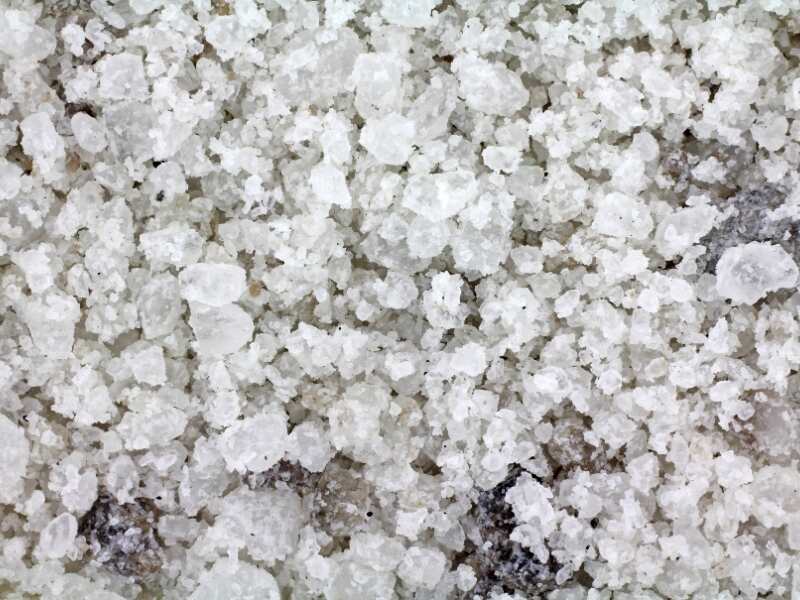
Photo Credit: BWFolsom / Canva Pro / License
If you live in a location with icy winters, you may have some rock salt on hand. This is the salt that eats away the ice. You can sprinkle some directly on the weeds or make a solution.
Rock Salt Solution:
— 1 cup of rock salt
— 1 gallon of hot water
How to Apply: Mix until the salt is dissolved. Pour into a spray bottle. Spray weeds directly. Respray the weeds after five days. Reapply the spray after waiting another five days. Avoid saturating the roots, as this can damage the soil and nearby plants. To protect your grass and ornamentals, water nearby vegetation after applying the salt solution to dilute it.
Boiling Water
Boil some water and pour it onto the weeds. This option, like all DIY weed killers, will damage your grass and other surrounding plants if it makes contact.
How to Apply: It is best to place the hot water in a vessel with a spout, like a teapot. Allow it to soak into the plant roots. However, it may not kill the roots, which can result in weed regrowth.
Rubbing Alcohol
Rubbing alcohol kills weeds by draining moisture from the leaves. It will also drain moisture from grass blades and the foliage of other plants, so be sure to spray it directly onto the weeds, and do your best to avoid overspray.
Rubbing Alcohol Solution:
— 2 tablespoons of alcohol
— 1 quart of water
How to Apply: Mix the solution in a spray bottle. Spray weeds individually, covering the leaves as much as possible with the solution.
Use Commercial Synthetic Herbicides
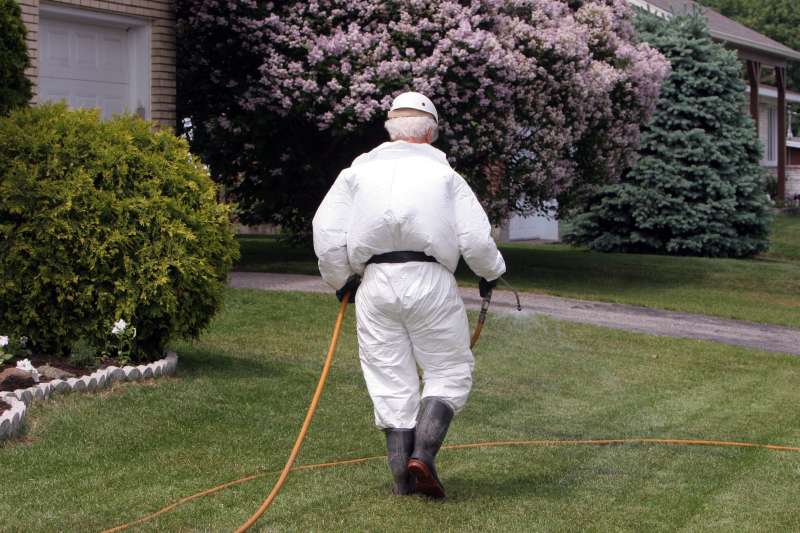
Photo Credit: Bouillante / Canva Pro / License
Synthetic herbicides come as pre-emergent, post-emergent, or as weed and feed products. These herbicides come with precautions as well as do’s and don’ts to be effective and not cause damage. Here are some examples:
— Be sure to use these at the right time of year and in the right temperature range. Pre-emergents and post-emergents work at different times, and if applied at the wrong time, they won’t do much at all.
— Synthetic herbicides can injure grass if applied during the wrong stage of your lawn’s growth. For example, pre-emergent products typically should only be applied to turfgrass that has been established for at least 12 months.
— Certain types of herbicides can only be used on certain grass types. Read product labels to find out which grass types it’s safe to use each product on.
— Not all chemicals kill all weeds. Some chemicals only work on broadleaf weeds, while others only work on grassy weeds. Some are even formulated to kill specific weed types. Read the product label carefully before purchasing a herbicide to make sure what you’re getting will actually work for the weeds on your lawn.
— Applying pre-emergents too soon after overseeding the lawn can prevent the new grass seeds from germinating.
Pre-Emergent Herbicides
Pre-emergent products must be applied before weed seeds start germinating. These herbicides kill weed seeds, but they do not kill grown weeds. Pre-emergent herbicides are for preventing future weeds, not getting rid of existing ones.
When to Apply: Administer in the spring for summer annual weeds, like crabgrass and goosegrass. Apply when the soil temperature is around 55 degrees Fahrenheit or above for about 2 days or more.
For winter annual weeds, like annual bluegrass and chickweed, apply in the early fall. The best time is when the soil temperature is approximately 70 degrees Fahrenheit for at least 3 days.
A note on soil temperature: Applying pre-emergents at the right soil temperature is imperative to their success, so use a soil thermometer to get an accurate reading. A soil thermometer costs about $10 or less at a local gardening store or online.
Selective vs Non-selective: Most pre-emergent herbicides used for lawn weeds are selective herbicides, meaning they kill specific weed seeds without damaging other plants.
Non-selective herbicides, on the other hand, target all plants. To avoid eliminating wanted plants and grass, spot-treat unwanted vegetation by applying non-selective herbicides with a handheld sprayer. These herbicides will also prevent grass from growing, so do not use them when you have recently seeded the lawn or plan to seed the lawn in the near future.
Post-Emergent Herbicides
Post-emergent herbicides kill weeds that are sprouting. Weeds that are young and actively growing are the most susceptible to these types of herbicides.
When to Apply: For perennial weeds and many types of annual weeds, the best time to apply post-emergent products is in the fall or late spring. Treat stubborn perennial weeds with deep root systems in the early spring. Apply when the soil temperature is greater than 55 degrees Fahrenheit and the air temperature is less than 85 degrees.
Contact vs Systemic: Like pre-emergent chemicals, post-emergents come as selective and non-selective. However, unlike pre-emergents, post-emergents destroy plant parts, such as stems and roots. They do this in different ways.
Contact-based post-emergent herbicides kill only the plant parts they come into contact with. They destroy parts above the ground, like the leaves. Completely killing weeds with contact herbicides may take many treatments, and you’ll have to manually remove the roots to prevent the weeds from coming back.
Systemic post-emergents kill the entire plant regardless of contact with specific parts. The weed absorbs the chemicals, which travel through the vegetation and attack its vascular system. The leaves, stems, and root systems are destroyed.
Weed and Feed
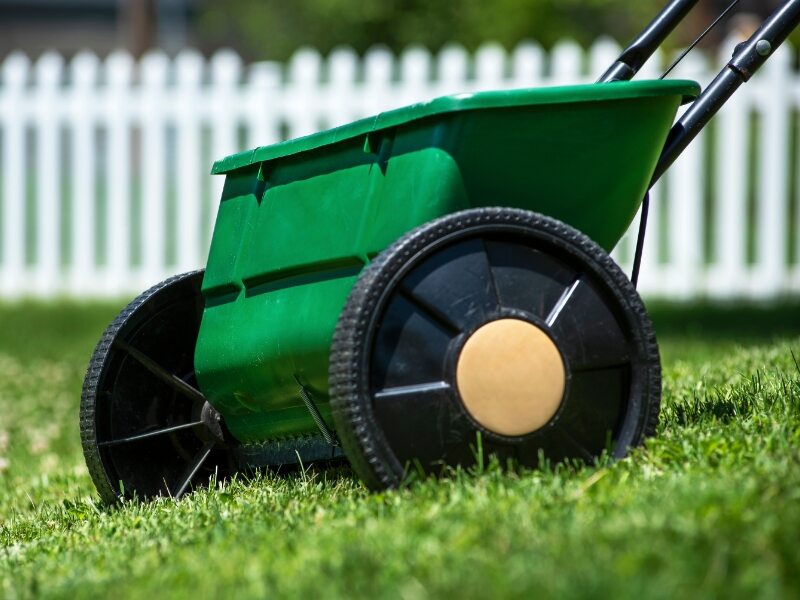
Photo Credit: Jon Rehg / Canva Pro / License
Weed and feed products are pre-emergent or post-emergent herbicides that also include lawn fertilizer. If applied at the right time, weed and feed can improve your grass and promote a thriving, green lawn at the same time as removing weeds. A healthy lawn decreases the risk of weed growth in the future.
Weed and feed is somewhat controversial because it combines herbicides and fertilizer, two types of chemicals that have different requirements for application. For example, grass needs to be fertilized at specific times to be healthy. If the timing to apply the weed control portion is not the same as the timing for the fertilizer, you can damage the grass. Do not apply weed and feed more than two times a year. Always read the label to know when to apply.
Summary of Synthetic Chemicals
For pre-emergent, post-emergent, and weed and feed chemicals, read the labels to determine if the herbicide controls the weeds you are looking to manage, can be used on your grass type, and at what stage your grass is safe from being damaged by the chemicals.
For weed and feeds, make sure the time of year the herbicide should be used is the same as the time your grass requires fertilization.
Manual Ways to Get Rid of Weeds
Pulling weeds by hand or using a tool may be a little more time-consuming than other DIY methods or using synthetic chemicals. It may take more effort, too. The benefit is that manual methods will not release substances that can harm you, your loved ones, or the environment or change the soil composition.
Pull Weeds by Hand or With a Tool

Photo Credit: Artur Henryk Bialosiewicz / Canva Pro / License
These methods are best when you have a few weeds, and they are young. Wear gloves when removing weeds manually.
How to Pull Weeds By Hand or With a Tool: Water the area or wait until after it rains. The wet ground makes it easier to pull up roots. Dig around the weed with a pointed garden trowel or weeding tool to loosen the soil. Use your hand or tool to pull up as much of the root system as possible so the weed will not grow back.
For some weeds, like crabgrass, only pull by hand or tool when the seed head is closed. If you pull when the head is open, the seeds will spread and replant.
For nutsedge, pull it by hand if the plant has fewer than five leaves. If there are many of these weeds, use a dethatcher or hoe.
As you can see, whether you are applying DIY mixtures, synthetic chemicals, or manual methods, it is important to be able to identify the types of weeds you have so that you use the best weed control solution.
Weed Torch
This device is also called a flame weeder. It is a propane tank with a wand attached that allows you to burn weeds. The flame weeder kills leaves and stem cells but does not kill the roots. It may take multiple treatments to eliminate weeds.
Obviously, since weed torches use an open flame to kill weeds, they can also harm your grass, or worse, you. Always wear protective clothing and a face covering when using a weed torch, and be very careful to keep the flame away from your grass and other plants you want to keep.
Prevent Weeds With Good Lawn Care
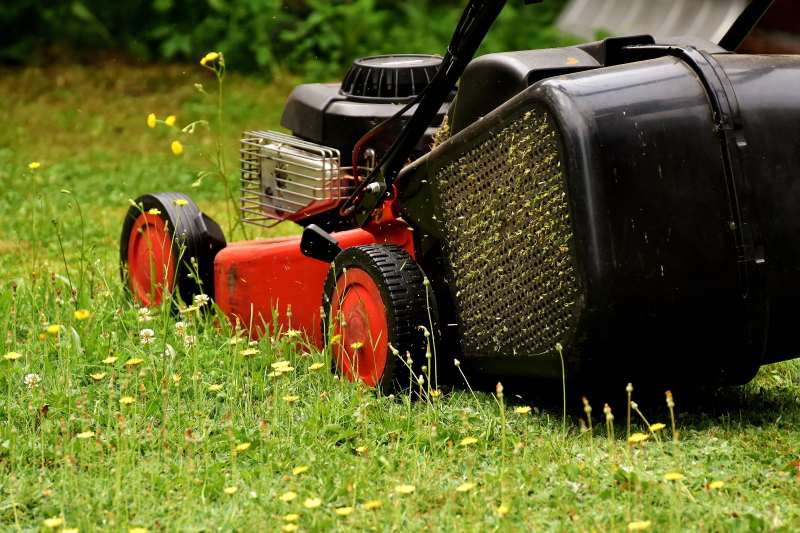
Photo Credit: Wallpaper Flare / License
The best way to manage weeds is through prevention by practicing appropriate seasonal lawn care and maintenance. A dense and healthy lawn with grass at an adequate height can crowd out and prevent weed seeds from getting sufficient sun. Weeds will be less likely to sprout because they cannot get the water, nutrients, and space they need to grow.
There are two categories of grass types: warm-season and cool-season grasses. Each type and the individual grasses within each type determine maintenance requirements, like mowing heights and the amount of fertilizer required. But here are some lawn maintenance practices that can be applied to grass in general for a weed-free lawn:
- Set the lawn mower to one of the higher settings. Mowing at one of the two top settings facilitates thicker and taller grass growth, which blocks weeds from getting sunlight. Taller grass also shades the soil, preventing weed seeds from getting the sunlight they need to grow.
- Overseed bare spots to make sure there are no patches where weeds can sprout.
- Water the grass deeply and infrequently to help the lawn establish deeper roots. This results in the thicker grass that is needed to crowd out weeds. Watering shallowly and often can cause the grass to be injured by heat and drought, leaving thin grass or patches where weeds can emerge.
- Use organic lawn fertilizer to help the grass grow thick, which will choke out weeds.
- Do not allow grass clippings to remain on the lawn when there are weeds growing in your yard. If you have weeds, using grass clippings as fertilizer or mulch will spread the seeds. Make sure your lawn mower is not in mulching mode, as it will disseminate the clippings back onto the lawn.
- Aerate the lawn to loosen the soil, allowing the grass roots to breathe. Lawn aeration also helps the lawn absorb nutrients necessary to grow healthy, which in turn helps with weed control.
- Dethatch the grass at the recommended time intervals for your grass type. You should dethatch your lawn whenever the thatch layer reaches about an inch thick.
FAQ About Lawn Weed Control
How long does it take for a salt solution to kill weeds?
Salt usually kills weeds in about 10 days.
Is herbicidal vinegar dangerous?
Vinegar containing more than 11% acetic acid can burn your skin and cause eye injuries, including blindness. Wear gloves, goggles, and protective clothing when using herbicidal vinegar.
Are there any chemicals that can be used on both cool and warm-season grass?
Prodiamine is a pre-emergent herbicide that is safe to use on most warm and cool-season grass types. The post-emergent chemicals sulfentrazone and halosulfuron are safe for most types of grass.
Final Thoughts
Fortunately, you have options to get rid of weeds in grass. The goal is not only to stop weeds before they sprout or kill them after sprouting but to have a healthy lawn that outcompetes weeds. For help keeping your lawn as thick and thriving as it can be, reach out to a local lawn care pro on WikiLawn and find out how much a regular lawn maintenance plan would cost for you.
Main Photo Credit: SchulteProductions / Canva Pro / License